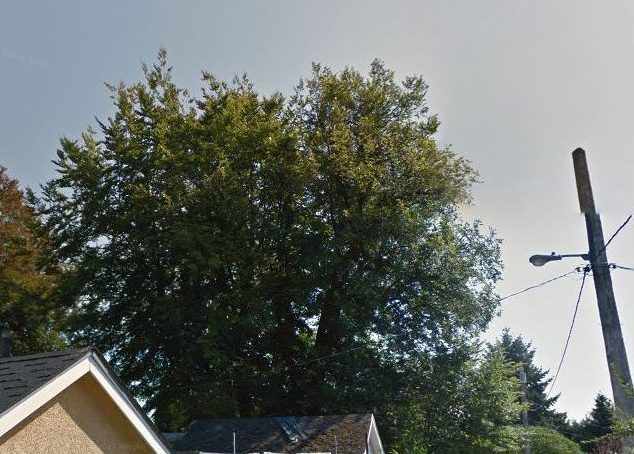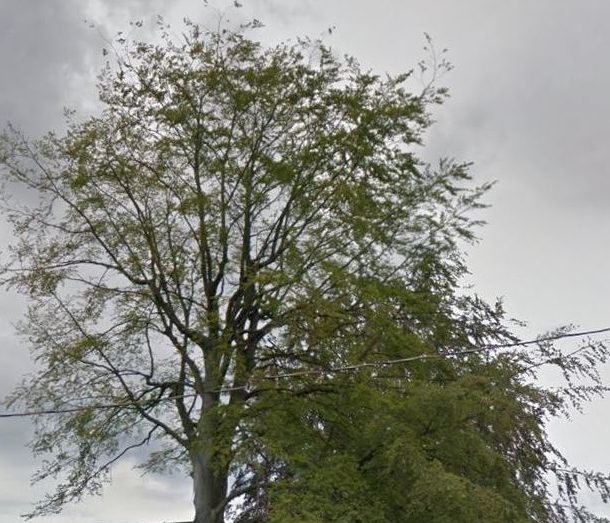A few years back when I was still complaining about the City’s lack of action on a Tree Bylaw, I pointed out the presence of a great beech trees on my street. This was one of three, gigantic, more than 100 years old, trunks more than a metre across. They provide so many benefits to the neighbourhood and the community: shade, noise abatement, wildlife habitat, storm water detention, cooling the air.
These three had “heritage” protection, so they were unlikely to be capriciously removed, but that limited protection was not afforded to most trees in the City. The vast majority were afforded almost no protection – if the landowner chose to remove them, she was good to go. A Bylaw was needed, and through the lengthy development of an Urban Forest Management Strategy, these newly-monikered “specimen trees” are protected from removal by short-term thinking.
I was shocked last week when a neighbour came over to complain to me that the City had allowed one of the three grand beech trees to be removed. “I thought there was a Bylaw!”
Alas, I wandered over to the property in question, and indeed one of the three is no more. No more than pile of alarmingly large slices of wood, as the arbourists were working on site clean-up. I noticed a Tree Removal Permit attached to the house, so clearly they got permission, but I felt the loss as much as my concerned neighbour. So I called up staff and we have had some discussions about this tree.
*I am trying to be careful here, because the homeowner who owned the tree did not do anything wrong, and I don’t want to cause them embarrassment or any kind of trouble, but a few people have asked me about the loss of this tree, and now there is a story in the Paper, so I felt like I needed to comment about it here. It will be difficult to tell the story without providing clues about the location, and I think people need to know the story of the loss of a community asset like this. So please, be respectful of the homeowner who – I’ll say it again – did nothing wrong here. If you feel the need to act out or speak up or react negatively, do it to me and Council, not them. Thanks.*
The story of this tree is that it was suffering from senescence, which is the technical way of saying it was dying of old age. I don’t want to get into the detailed description given by the arbourist, partly because I’m not an arbourist and may not clearly translate their terminology, and partly because there are probably FOIPPA issues in releasing a report provided to the City without passing it through the privacy protection filter.

Our efforts to look back are, fortunately, assisted by technology. Google Street View has photos both from 2011 and from 2016 on adjacent streets. The visible decline of the tree is obvious. It looked (again, to my untrained eye) healthy in 2011, but by 2016, the leaves are sparse and diminutive, many branches looking bare. There was quite a bit more evidence of decline in the arborist report, but there is no doubt this tree was not very happy.

The contributing factors to a tree like this entering full-plant senescence are usually multiple. Sometimes there is an attack by a pest, and the drought-like conditions we have experienced for a couple of summers probably hurt the resiliency of the tree. It is possible (I’m just speculating here) that poor pruning practice or damage to the roots for home improvements may have also been a factor, further reducing the ability of the tree to cope with declining productivity.
In the end, the things that made the tree so majestic – its great size and hulking branches – are the things that made it a “hazardous tree” once that decline began. The arbourist did not think this was a temporary setback, and that recovery was unlikely. what was more likely was continued decline until the branches started to collapse, potentially onto a building or person. The homeowner got a permit, had a tree health assessment done, and received permission to cut the tree down.
As this is a “specimen” size tree, and a hazardous one, Schedule A of the Bylaw indicates that the homeowner is required to replace the tree, and the City collects security to assure that replacement takes place. Of course, putting a new dogwood or birch sapling in the place does not really “replace” a 100+ year old giant like what was lost. It will be decades until the replacement starts to provide the mass of benefits that the old tree did. But even this replacement policy did not exist before the Bylaw.
Which bring me to the point – the Tree Protection Bylaw does not mean no trees will ever be removed again. What it means is that the City has applied measures (call it Red Tape if you are so inclined) to act as disincentives to the removal of trees, and to provide compensation to the community for trees lost. When it comes to private property, that is about as far as we can go as a City. It has proven to work in other jurisdictions, though.
The Bylaw is only one part of our Urban Forest Management Strategy, but it is an important part, and this fall Council will be taking a closer look at the Bylaw application to see where it can be strengthened, and where it needs to be relaxed to make it more functional for residents. If you have opinions one way or another, please send Mayor and Council an e-mail or letter.